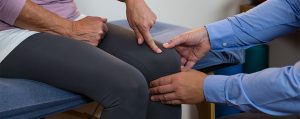Static Stretches for Improved Flexibility
Are you dealing with tight muscles, or maybe you don’t feel very flexible? When used correctly, stretching can be a useful tool to address tight muscles and improve muscle flexibility. Recent studies have confirmed that performing low intensity stretches over a long period can improve flexibility. Let’s look at a handful of simple stretches you can do to improve tight muscles.
How To Do Your First Pull-Up
My first experience with pull-ups was back in elementary school for the presidential fitness testing that we all had to go through. I remember seeing my classmates being able to perform numerous repetitions, and I remember how I felt when I couldn’t do any. When testing came around during my 6th-grade year, I could finally perform one pull-up! I felt on top of the world that day. Looking back at that testing, it seems like a simple task but intimidating at the same time. There’s a bar hanging off the wall, and all you have to do is pull yourself up high enough that your chin passes the bar; it all sounds so easy. But, for some, it’s just as big of a challenge as I went through. I want to help you be able to do your first pull-up, and for those of you who already can, I want to help you increase your proficiency with them. Once you can do them, the world can become your gym as you’ve added a new exercise to do regularly. Are you playing with the kids at a park? You can use the monkey bars to get a back workout in.
Why Is There Swelling After an Injury?
Most of us have had an instance where we stepped funny and twisted our ankle or knee, maybe stretched our shoulder too far, or tripped and injured our wrist. These are examples of an acute injury. Acute injuries are usually the result of a single traumatic event. This is in contrast to a chronic injury that occurs with repetition and over time. Swelling is a common occurrence after injury. Swelling is a normal reaction to injury; however, the swelling reaction is excessive sometimes. Let’s look at what happens when your body has swelling after an injury.
Injury Prevention for Keeping Your Hands Healthy This Spring and Summer
Earlier months in the year have come and gone, and the routines of the cold weather months may be changing. Increased daylight hours have allowed for more time outdoors, participating in leisure and work. As the events that consume our free time begin to change, the physical demands on our bodies, specifically our hands, ought to be thought about and considered to prevent injury.
Why does Exercise Make You Feel Better?
We’ve all been through it, the dreaded pre-exercise blues. Not quite sure if you want to go through with it; there are a million other things you could be doing instead. But you know that you will feel better if you do exercise, and while removing the guilt of not exercising is partly the reason, there is a scientific basis for why exercise makes us feel better.
Exercises to Improve your Golf Swing
Power or mobility? Range of motion or strength? As you begin to adapt your body for better performance on the golf course this spring, you need to figure out first what you need. This article will discuss the major stumbling blocks that I see the most with patients. These corrections are great for getting out of a chair the following day after a round of golf. They can also increase your power off the tee or on approach.
Ways Stress Can Affect Your Health
We all deal with stress from time to time, with some periods of our lives being more stressful than others. Everyone handles stress differently; some can cope with stress better than others, and some give in to the slightest bit of stress. Some use positive coping mechanisms like exercise and meditation, while others use negative coping mechanisms like substance use or other destructive behaviors. With all this increase in stress over recent years and decades, modern medicine has demonstrated within the past few years the effects stress can have on our physical and mental health, both long-term and short-term.
Exercises to Relieve your Neck and Upper Back Tension
If you’re like the millions of Americans across the county, you may find yourself working at a job that requires an extensive amount of sitting, computer work, or meetings that don’t allow you to move and change positions as often as you need. According to the American Heart Association, over 80% of jobs are sedentary, requiring excessive sitting and not enough physical activity.1 Because of the pandemic, many of us are now working from home, which only increases the amount of time we spend sitting. Data shows that between 15 and 34% of desk workers will experience neck pain related to their job. Work-related neck pain is the leading cause of disability and absence from work.2
